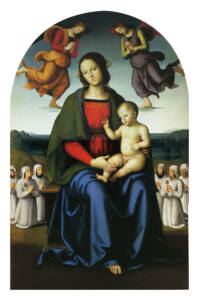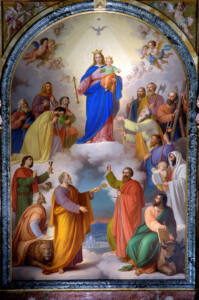
WelCom February 2024
The final segment of this series in which Fr James Lyons has explored titles of Mary, the Mother of Jesus, as found in the 16th century Litany of Loreto.
Comforter of the afflicted
Many years ago, in a broadcast training session, I learned that writers of religious talks for radio should aim to produce scripts that ‘comfort the disturbed and disturb the comfortable’. This is the aim of any preacher or ‘proclaimer of the Word’ who, following the example of Jesus Christ, is sensitive to the importance and significance of compassion and challenge.
As a title honouring Mary, the mother of Jesus, Comforter of the Afflicted would seem to favour the compassionate aspect. We might be tempted to see Mary as a ‘soft touch’, someone to run to when things aren’t going our way. Someone who’ll take our part and reassure us with ‘There, there!’ and ‘Don’t worry!’. Someone who’ll ‘kiss it better’ and make everything all right.
But this is not the comfort Mary offers. Mary is not the one to approach if that is the kind of comfort we are seeking.
A comforter is a person who comforts or consoles me; someone who lessens the severity of my grief or disappointment. A comforter doesn’t take the pain away or allow me to pretend, but shows a level of understanding, likely to come from their own lived experience. Their closeness, or empathy, makes the pain more bearable, even perhaps giving the pain some meaning or purpose.
An encounter with Mary – who found her own comfort in the gift of herself – will open a way for the afflicted to recognise affliction and to become comforters themselves.
In this sense, the comforter is also a disturber – stirring up within the one being comforted other feelings about themselves or their relationships that may need some attention, healing or redirection.
Mary, Comforter of the Afflicted, welcomes with open arms anyone lost or troubled, hurt or broken, lonely, sad, afflicted in any way. She welcomes them for she knows they are the very ones Jesus came to seek out with his message of hope.
Comforting is multi-dimensional. It is touch and spoken word; it is presence, it is both listening and hearing, and it is silence. To be with someone suffering in a positive way is to recognise their need and to sense the best response. The comforter leaves the ‘self’ out of being and replaces it with the ‘other’.
But, like her Son, Mary knows that no one can be truly comforted without also being challenged. An encounter with Mary – who found her own comfort in the gift of herself – will open a way for the afflicted to recognise affliction and to become comforters themselves.
I knew before she spoke.
Something in the gap between
my greeting in opening the call
and her words
‘Mum died last night.’
The news came before the words.
The silent moment
cradled new born grief
and told me pain was near.
Listen to the silence.
It is the space between us
filled with invitations to enter.
Listen to the silence.
It is the voice of all in need
of comfort and a heart that loves.
Mary, Comforter of the Afflicted.
Pray for us.
Help of Christians

This invocation was added to the Litany of Loreto following the Battle of Lepanto (7 October 1571).
Catholics throughout Europe had prayed the Rosary for Our Lady’s intercession and protection and attributed victory to her help. This became the date for the Feast of Our Lady of the Rosary.
Following the release of Pope Pius VII from imprisonment under Napoleon in 1813, the Pope instituted the Feast of Our Lady, Help of Christians, to be honoured each year on 24 May.
But, from the earliest days of the Christian era, Mary of Nazareth, the mother of Jesus the Christ, has been recognised as the ideal advocate, a person to call on in time of need.
The wedding at Cana (John 2:1-11) has Mary, aware of a potential embarrassment for the hosts and a social gaffe with the wine running out, encouraging Jesus to save the day. Her caring motherhood steps in to defuse a cultural and family disaster, pointing out to Jesus that they have no wine.
Her words to the wine stewards: Do whatever he tells you, have relevance for all who would follow Jesus. Mary’s intercessory power has consequences for all seeking her help: we are to listen more closely to Jesus and act on his words.
Mary accompanied Jesus on his mission and stood with him even when others fled. The only Apostle with her at the foot of the cross as Jesus died, was John. The others abandoned him and ran away.
But Mary did not abandon them.
She helped all the disciples with her presence and her unfailing love, gathering with them as they regrouped, shamefaced and humbled (cf Acts 1:12-14).
Mary, as mother of Jesus, is mother of the Body of Christ, the Church, the People of God. She is our mother, gifted by Jesus from the cross to John and, through him to all who follow the Christian way.
When Jesus saw his mother and the disciple whom he loved standing beside her, he said to his mother, ‘Woman, this is your son.’ Then he said to the disciple, ‘Here is your mother.’ And from that hour the disciple took her into his own home. (John 19:26-27)
Motherhood carries a special gene of care. The unique and, in a sense, unbreakable bond between mother and child, holds them close regardless of the separation that comes with time and distance.
Pope St John Paul II writes, ‘Mary, who from the beginning had given herself without reserve to the person and work of her Son, could not but pour out upon the Church, from its infancy, her maternal self-giving. After her Son’s departure, her motherhood remains…interceding for all her children….’ (Redemptoris Mater – Mary, in the Life of the Pilgrim Church, 1987, n.40)
Mary, woman of care.
Sensitive to the needs of your children.
Your mothering is strong yet gentle
echoing your own time of being without.
Seeking security, safety and shelter,
exchanging Bethlehem for Egypt,
you learned the secret of suffering
and the healing power of love.
Comfort us in our uncertainty.
Strengthen our trembling
that, like you, we may be
strong in faith.
unbending in hope.
generous in love.
Mary, Help of Christians – Pray for us.
The Battle of Lepanto, a large naval engagement involving more than 400 warships, took place on 7 October 1571 in the waters off southwestern Greece. A fleet of the Holy League, a coalition of Catholic states arranged by Pope Pius V, inflicted a major defeat on the fleet of the Ottoman Empire in the Gulf of Patras during an Ottoman campaign to acquire the Venetian island of Cyprus.